Leadership Styles: Transactional, Transformative, and Strategic
VerifiedAdded on 2022/10/02
|6
|1429
|282
Essay
AI Summary
This essay examines various leadership styles, with a particular focus on transactional leadership. It begins by defining transactional leadership and illustrating its application through a case study of a leader named Wassmiah. The essay then explores the advantages of this leadership style, such as its structured approach and focus on achieving short-term goals through rewards and penalties. However, it also acknowledges the disadvantages, including limited employee creativity and the potential for a lack of intrinsic motivation. The implications of transactional leadership on employee motivation are discussed, highlighting how it can improve efficiency and commitment. The essay also identifies other leadership styles, such as transformative, strategic, and autocratic leadership, that are complementary to the transactional approach. The conclusion emphasizes that while different leadership styles suit different organizational contexts, transactional and transformative styles are particularly effective in business settings, as they drive organizational development by achieving goals and objectives.

Running head: LEADERSHIP STYLES 1
Leadership Styles
Name
Institution
Leadership Styles
Name
Institution
Paraphrase This Document
Need a fresh take? Get an instant paraphrase of this document with our AI Paraphraser
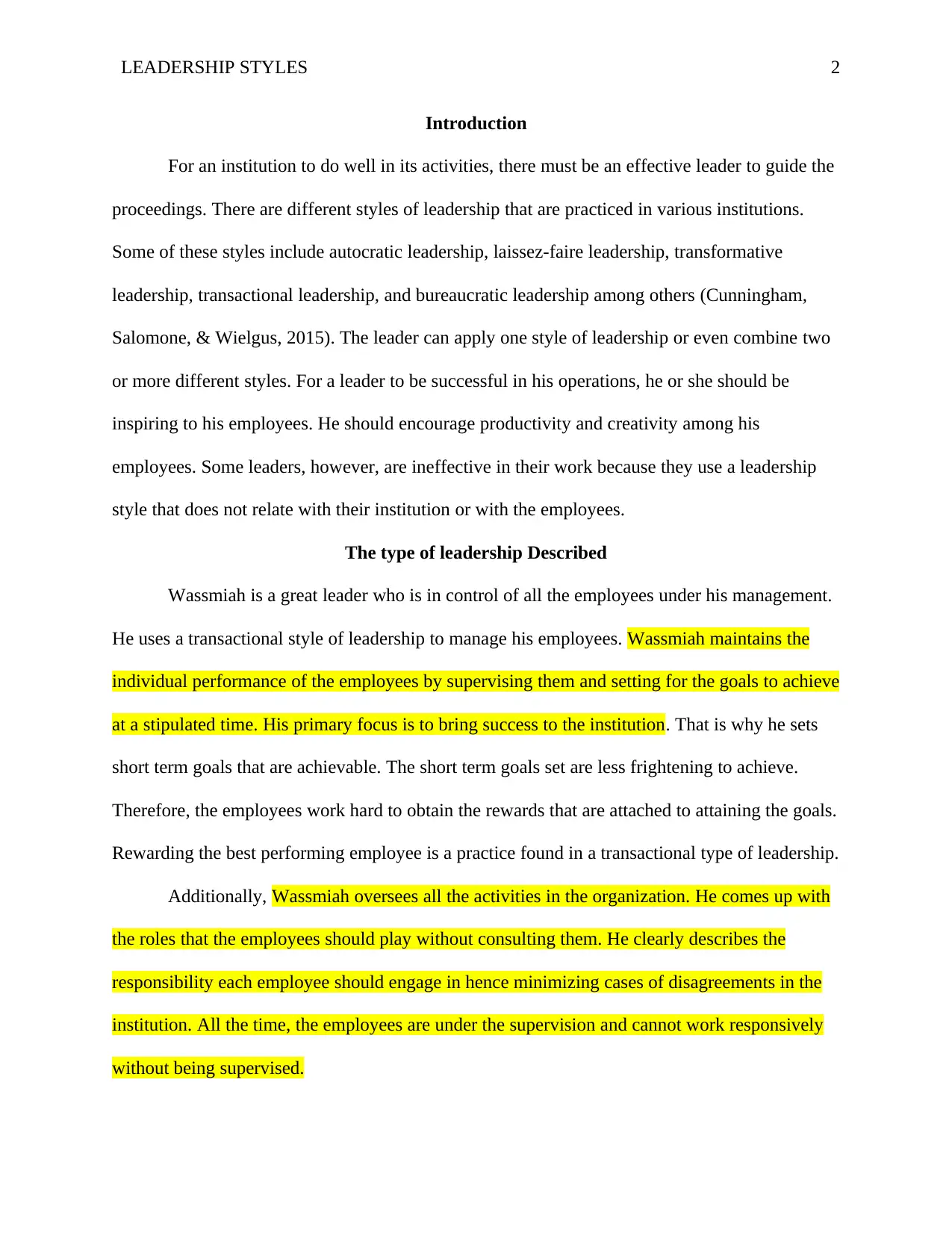
LEADERSHIP STYLES 2
Introduction
For an institution to do well in its activities, there must be an effective leader to guide the
proceedings. There are different styles of leadership that are practiced in various institutions.
Some of these styles include autocratic leadership, laissez-faire leadership, transformative
leadership, transactional leadership, and bureaucratic leadership among others (Cunningham,
Salomone, & Wielgus, 2015). The leader can apply one style of leadership or even combine two
or more different styles. For a leader to be successful in his operations, he or she should be
inspiring to his employees. He should encourage productivity and creativity among his
employees. Some leaders, however, are ineffective in their work because they use a leadership
style that does not relate with their institution or with the employees.
The type of leadership Described
Wassmiah is a great leader who is in control of all the employees under his management.
He uses a transactional style of leadership to manage his employees. Wassmiah maintains the
individual performance of the employees by supervising them and setting for the goals to achieve
at a stipulated time. His primary focus is to bring success to the institution. That is why he sets
short term goals that are achievable. The short term goals set are less frightening to achieve.
Therefore, the employees work hard to obtain the rewards that are attached to attaining the goals.
Rewarding the best performing employee is a practice found in a transactional type of leadership.
Additionally, Wassmiah oversees all the activities in the organization. He comes up with
the roles that the employees should play without consulting them. He clearly describes the
responsibility each employee should engage in hence minimizing cases of disagreements in the
institution. All the time, the employees are under the supervision and cannot work responsively
without being supervised.
Introduction
For an institution to do well in its activities, there must be an effective leader to guide the
proceedings. There are different styles of leadership that are practiced in various institutions.
Some of these styles include autocratic leadership, laissez-faire leadership, transformative
leadership, transactional leadership, and bureaucratic leadership among others (Cunningham,
Salomone, & Wielgus, 2015). The leader can apply one style of leadership or even combine two
or more different styles. For a leader to be successful in his operations, he or she should be
inspiring to his employees. He should encourage productivity and creativity among his
employees. Some leaders, however, are ineffective in their work because they use a leadership
style that does not relate with their institution or with the employees.
The type of leadership Described
Wassmiah is a great leader who is in control of all the employees under his management.
He uses a transactional style of leadership to manage his employees. Wassmiah maintains the
individual performance of the employees by supervising them and setting for the goals to achieve
at a stipulated time. His primary focus is to bring success to the institution. That is why he sets
short term goals that are achievable. The short term goals set are less frightening to achieve.
Therefore, the employees work hard to obtain the rewards that are attached to attaining the goals.
Rewarding the best performing employee is a practice found in a transactional type of leadership.
Additionally, Wassmiah oversees all the activities in the organization. He comes up with
the roles that the employees should play without consulting them. He clearly describes the
responsibility each employee should engage in hence minimizing cases of disagreements in the
institution. All the time, the employees are under the supervision and cannot work responsively
without being supervised.
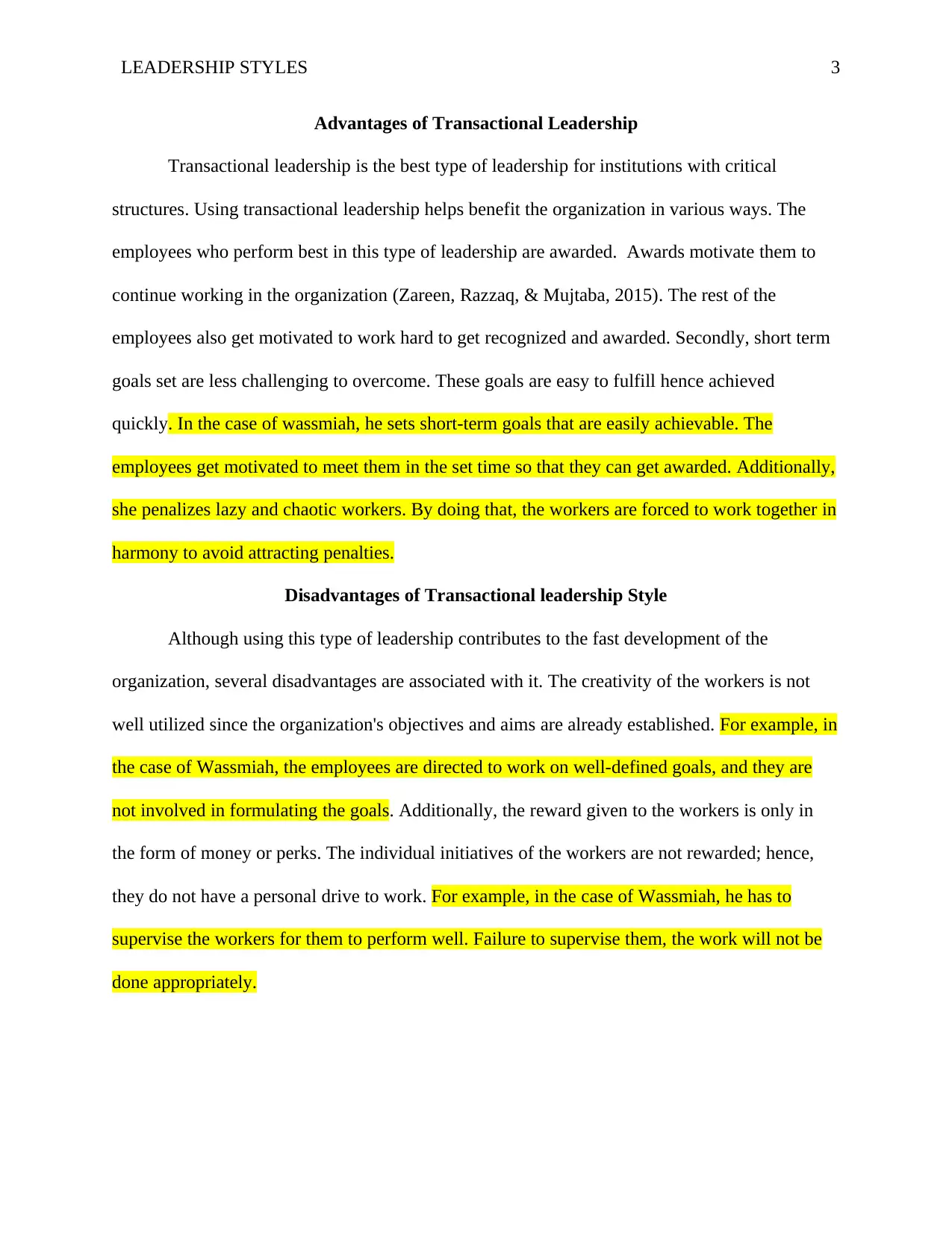
LEADERSHIP STYLES 3
Advantages of Transactional Leadership
Transactional leadership is the best type of leadership for institutions with critical
structures. Using transactional leadership helps benefit the organization in various ways. The
employees who perform best in this type of leadership are awarded. Awards motivate them to
continue working in the organization (Zareen, Razzaq, & Mujtaba, 2015). The rest of the
employees also get motivated to work hard to get recognized and awarded. Secondly, short term
goals set are less challenging to overcome. These goals are easy to fulfill hence achieved
quickly. In the case of wassmiah, he sets short-term goals that are easily achievable. The
employees get motivated to meet them in the set time so that they can get awarded. Additionally,
she penalizes lazy and chaotic workers. By doing that, the workers are forced to work together in
harmony to avoid attracting penalties.
Disadvantages of Transactional leadership Style
Although using this type of leadership contributes to the fast development of the
organization, several disadvantages are associated with it. The creativity of the workers is not
well utilized since the organization's objectives and aims are already established. For example, in
the case of Wassmiah, the employees are directed to work on well-defined goals, and they are
not involved in formulating the goals. Additionally, the reward given to the workers is only in
the form of money or perks. The individual initiatives of the workers are not rewarded; hence,
they do not have a personal drive to work. For example, in the case of Wassmiah, he has to
supervise the workers for them to perform well. Failure to supervise them, the work will not be
done appropriately.
Advantages of Transactional Leadership
Transactional leadership is the best type of leadership for institutions with critical
structures. Using transactional leadership helps benefit the organization in various ways. The
employees who perform best in this type of leadership are awarded. Awards motivate them to
continue working in the organization (Zareen, Razzaq, & Mujtaba, 2015). The rest of the
employees also get motivated to work hard to get recognized and awarded. Secondly, short term
goals set are less challenging to overcome. These goals are easy to fulfill hence achieved
quickly. In the case of wassmiah, he sets short-term goals that are easily achievable. The
employees get motivated to meet them in the set time so that they can get awarded. Additionally,
she penalizes lazy and chaotic workers. By doing that, the workers are forced to work together in
harmony to avoid attracting penalties.
Disadvantages of Transactional leadership Style
Although using this type of leadership contributes to the fast development of the
organization, several disadvantages are associated with it. The creativity of the workers is not
well utilized since the organization's objectives and aims are already established. For example, in
the case of Wassmiah, the employees are directed to work on well-defined goals, and they are
not involved in formulating the goals. Additionally, the reward given to the workers is only in
the form of money or perks. The individual initiatives of the workers are not rewarded; hence,
they do not have a personal drive to work. For example, in the case of Wassmiah, he has to
supervise the workers for them to perform well. Failure to supervise them, the work will not be
done appropriately.
⊘ This is a preview!⊘
Do you want full access?
Subscribe today to unlock all pages.

Trusted by 1+ million students worldwide
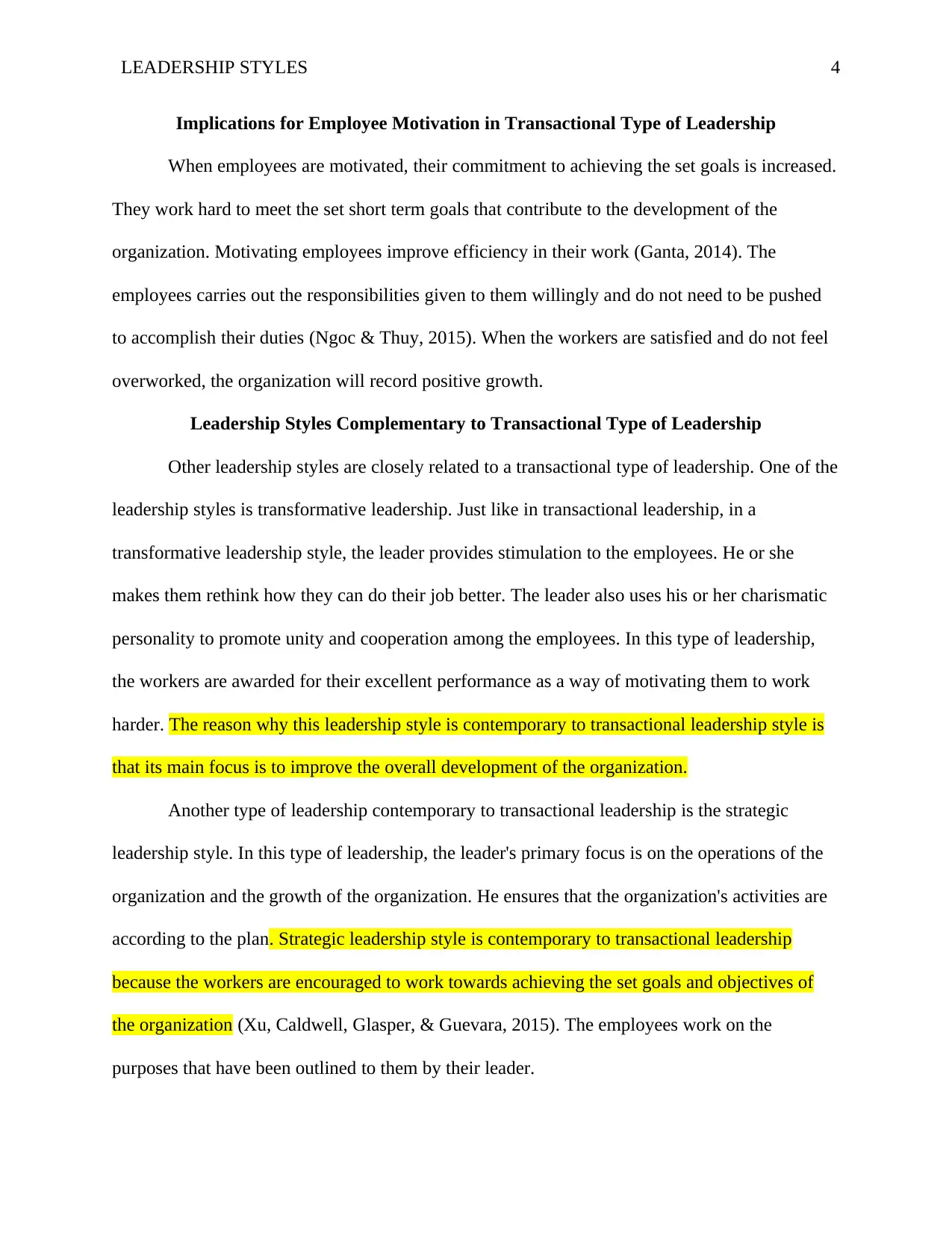
LEADERSHIP STYLES 4
Implications for Employee Motivation in Transactional Type of Leadership
When employees are motivated, their commitment to achieving the set goals is increased.
They work hard to meet the set short term goals that contribute to the development of the
organization. Motivating employees improve efficiency in their work (Ganta, 2014). The
employees carries out the responsibilities given to them willingly and do not need to be pushed
to accomplish their duties (Ngoc & Thuy, 2015). When the workers are satisfied and do not feel
overworked, the organization will record positive growth.
Leadership Styles Complementary to Transactional Type of Leadership
Other leadership styles are closely related to a transactional type of leadership. One of the
leadership styles is transformative leadership. Just like in transactional leadership, in a
transformative leadership style, the leader provides stimulation to the employees. He or she
makes them rethink how they can do their job better. The leader also uses his or her charismatic
personality to promote unity and cooperation among the employees. In this type of leadership,
the workers are awarded for their excellent performance as a way of motivating them to work
harder. The reason why this leadership style is contemporary to transactional leadership style is
that its main focus is to improve the overall development of the organization.
Another type of leadership contemporary to transactional leadership is the strategic
leadership style. In this type of leadership, the leader's primary focus is on the operations of the
organization and the growth of the organization. He ensures that the organization's activities are
according to the plan. Strategic leadership style is contemporary to transactional leadership
because the workers are encouraged to work towards achieving the set goals and objectives of
the organization (Xu, Caldwell, Glasper, & Guevara, 2015). The employees work on the
purposes that have been outlined to them by their leader.
Implications for Employee Motivation in Transactional Type of Leadership
When employees are motivated, their commitment to achieving the set goals is increased.
They work hard to meet the set short term goals that contribute to the development of the
organization. Motivating employees improve efficiency in their work (Ganta, 2014). The
employees carries out the responsibilities given to them willingly and do not need to be pushed
to accomplish their duties (Ngoc & Thuy, 2015). When the workers are satisfied and do not feel
overworked, the organization will record positive growth.
Leadership Styles Complementary to Transactional Type of Leadership
Other leadership styles are closely related to a transactional type of leadership. One of the
leadership styles is transformative leadership. Just like in transactional leadership, in a
transformative leadership style, the leader provides stimulation to the employees. He or she
makes them rethink how they can do their job better. The leader also uses his or her charismatic
personality to promote unity and cooperation among the employees. In this type of leadership,
the workers are awarded for their excellent performance as a way of motivating them to work
harder. The reason why this leadership style is contemporary to transactional leadership style is
that its main focus is to improve the overall development of the organization.
Another type of leadership contemporary to transactional leadership is the strategic
leadership style. In this type of leadership, the leader's primary focus is on the operations of the
organization and the growth of the organization. He ensures that the organization's activities are
according to the plan. Strategic leadership style is contemporary to transactional leadership
because the workers are encouraged to work towards achieving the set goals and objectives of
the organization (Xu, Caldwell, Glasper, & Guevara, 2015). The employees work on the
purposes that have been outlined to them by their leader.
Paraphrase This Document
Need a fresh take? Get an instant paraphrase of this document with our AI Paraphraser
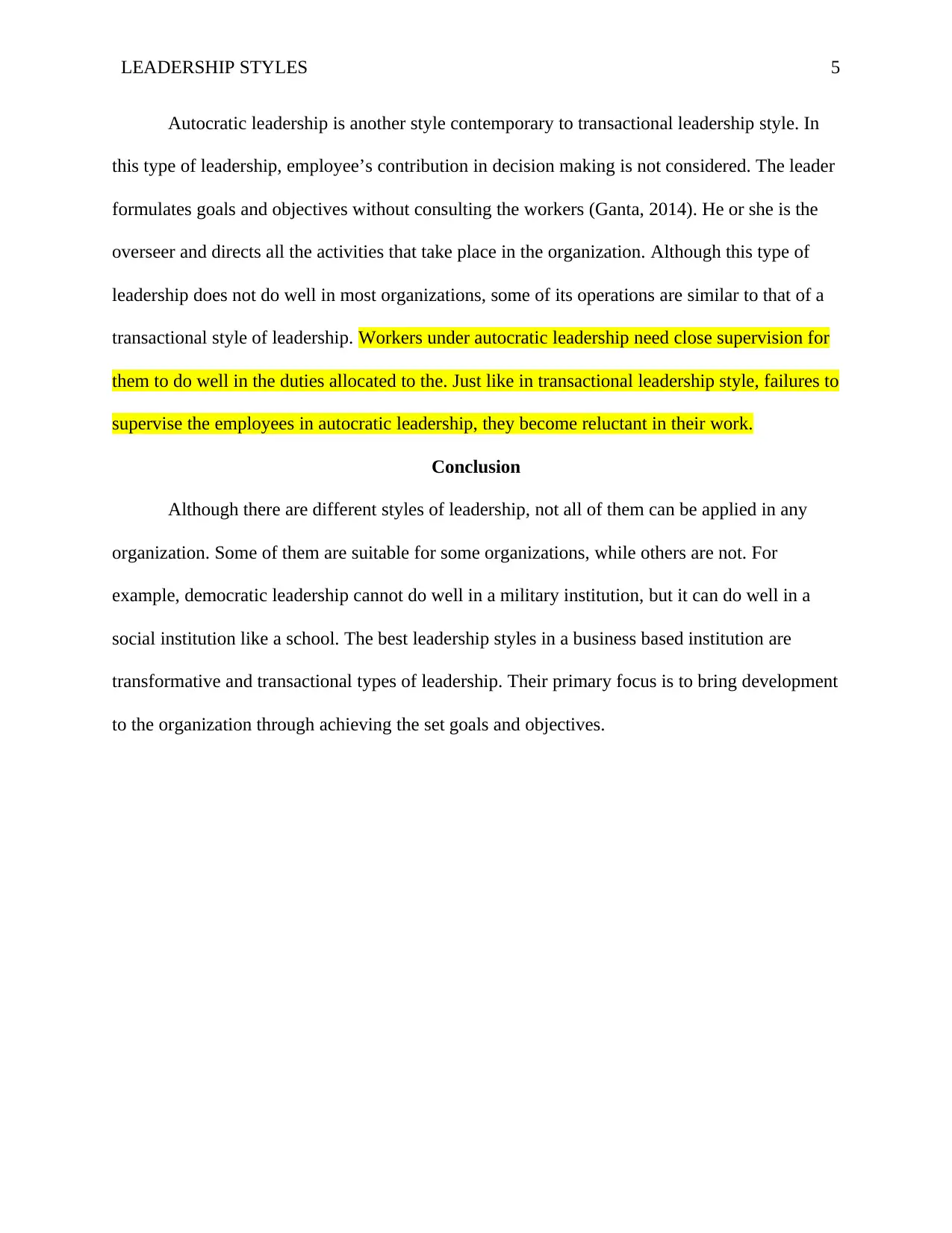
LEADERSHIP STYLES 5
Autocratic leadership is another style contemporary to transactional leadership style. In
this type of leadership, employee’s contribution in decision making is not considered. The leader
formulates goals and objectives without consulting the workers (Ganta, 2014). He or she is the
overseer and directs all the activities that take place in the organization. Although this type of
leadership does not do well in most organizations, some of its operations are similar to that of a
transactional style of leadership. Workers under autocratic leadership need close supervision for
them to do well in the duties allocated to the. Just like in transactional leadership style, failures to
supervise the employees in autocratic leadership, they become reluctant in their work.
Conclusion
Although there are different styles of leadership, not all of them can be applied in any
organization. Some of them are suitable for some organizations, while others are not. For
example, democratic leadership cannot do well in a military institution, but it can do well in a
social institution like a school. The best leadership styles in a business based institution are
transformative and transactional types of leadership. Their primary focus is to bring development
to the organization through achieving the set goals and objectives.
Autocratic leadership is another style contemporary to transactional leadership style. In
this type of leadership, employee’s contribution in decision making is not considered. The leader
formulates goals and objectives without consulting the workers (Ganta, 2014). He or she is the
overseer and directs all the activities that take place in the organization. Although this type of
leadership does not do well in most organizations, some of its operations are similar to that of a
transactional style of leadership. Workers under autocratic leadership need close supervision for
them to do well in the duties allocated to the. Just like in transactional leadership style, failures to
supervise the employees in autocratic leadership, they become reluctant in their work.
Conclusion
Although there are different styles of leadership, not all of them can be applied in any
organization. Some of them are suitable for some organizations, while others are not. For
example, democratic leadership cannot do well in a military institution, but it can do well in a
social institution like a school. The best leadership styles in a business based institution are
transformative and transactional types of leadership. Their primary focus is to bring development
to the organization through achieving the set goals and objectives.
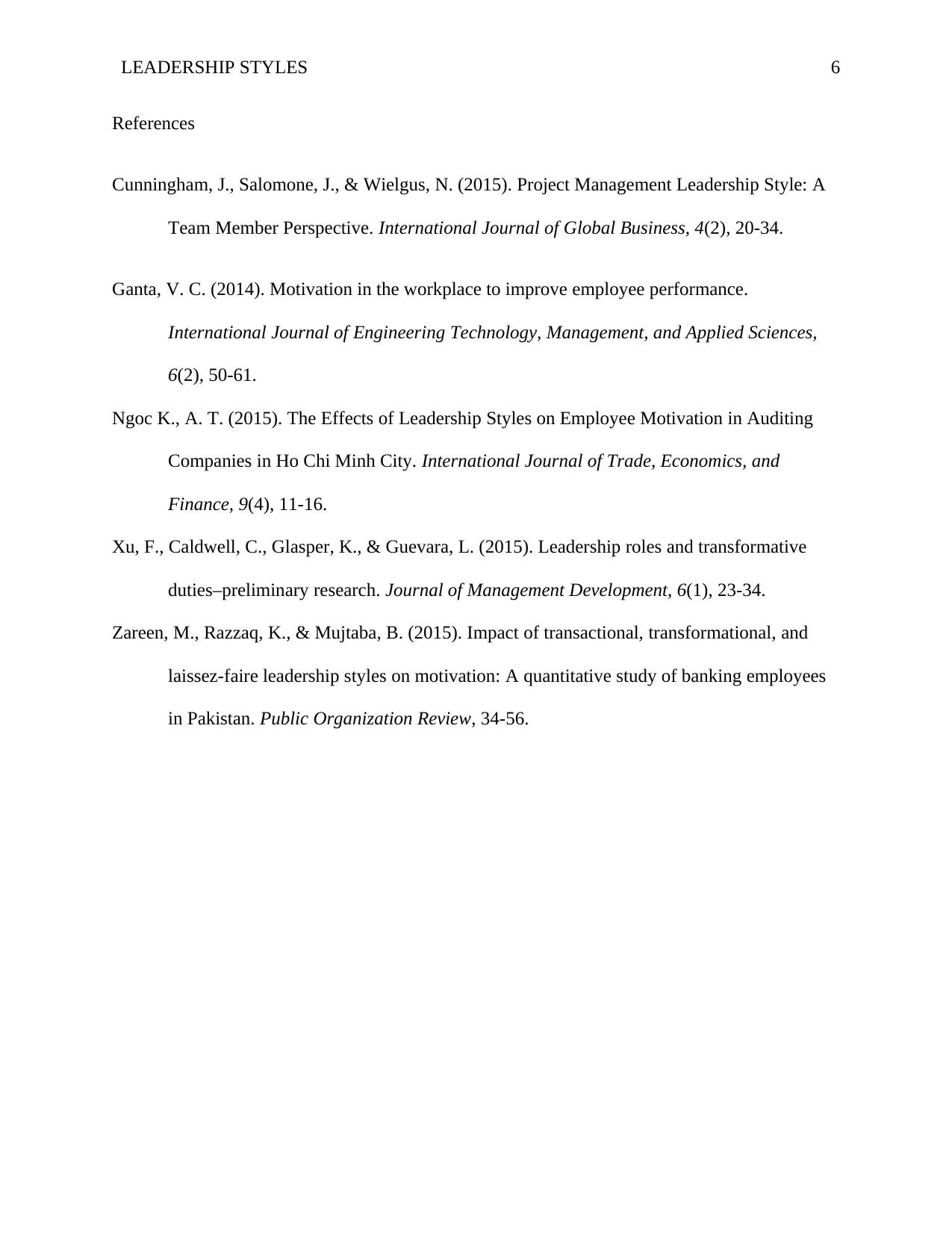
LEADERSHIP STYLES 6
References
Cunningham, J., Salomone, J., & Wielgus, N. (2015). Project Management Leadership Style: A
Team Member Perspective. International Journal of Global Business, 4(2), 20-34.
Ganta, V. C. (2014). Motivation in the workplace to improve employee performance.
International Journal of Engineering Technology, Management, and Applied Sciences,
6(2), 50-61.
Ngoc K., A. T. (2015). The Effects of Leadership Styles on Employee Motivation in Auditing
Companies in Ho Chi Minh City. International Journal of Trade, Economics, and
Finance, 9(4), 11-16.
Xu, F., Caldwell, C., Glasper, K., & Guevara, L. (2015). Leadership roles and transformative
duties–preliminary research. Journal of Management Development, 6(1), 23-34.
Zareen, M., Razzaq, K., & Mujtaba, B. (2015). Impact of transactional, transformational, and
laissez-faire leadership styles on motivation: A quantitative study of banking employees
in Pakistan. Public Organization Review, 34-56.
References
Cunningham, J., Salomone, J., & Wielgus, N. (2015). Project Management Leadership Style: A
Team Member Perspective. International Journal of Global Business, 4(2), 20-34.
Ganta, V. C. (2014). Motivation in the workplace to improve employee performance.
International Journal of Engineering Technology, Management, and Applied Sciences,
6(2), 50-61.
Ngoc K., A. T. (2015). The Effects of Leadership Styles on Employee Motivation in Auditing
Companies in Ho Chi Minh City. International Journal of Trade, Economics, and
Finance, 9(4), 11-16.
Xu, F., Caldwell, C., Glasper, K., & Guevara, L. (2015). Leadership roles and transformative
duties–preliminary research. Journal of Management Development, 6(1), 23-34.
Zareen, M., Razzaq, K., & Mujtaba, B. (2015). Impact of transactional, transformational, and
laissez-faire leadership styles on motivation: A quantitative study of banking employees
in Pakistan. Public Organization Review, 34-56.
⊘ This is a preview!⊘
Do you want full access?
Subscribe today to unlock all pages.

Trusted by 1+ million students worldwide
1 out of 6
Related Documents
Your All-in-One AI-Powered Toolkit for Academic Success.
+13062052269
info@desklib.com
Available 24*7 on WhatsApp / Email
![[object Object]](/_next/static/media/star-bottom.7253800d.svg)
Unlock your academic potential
Copyright © 2020–2025 A2Z Services. All Rights Reserved. Developed and managed by ZUCOL.



